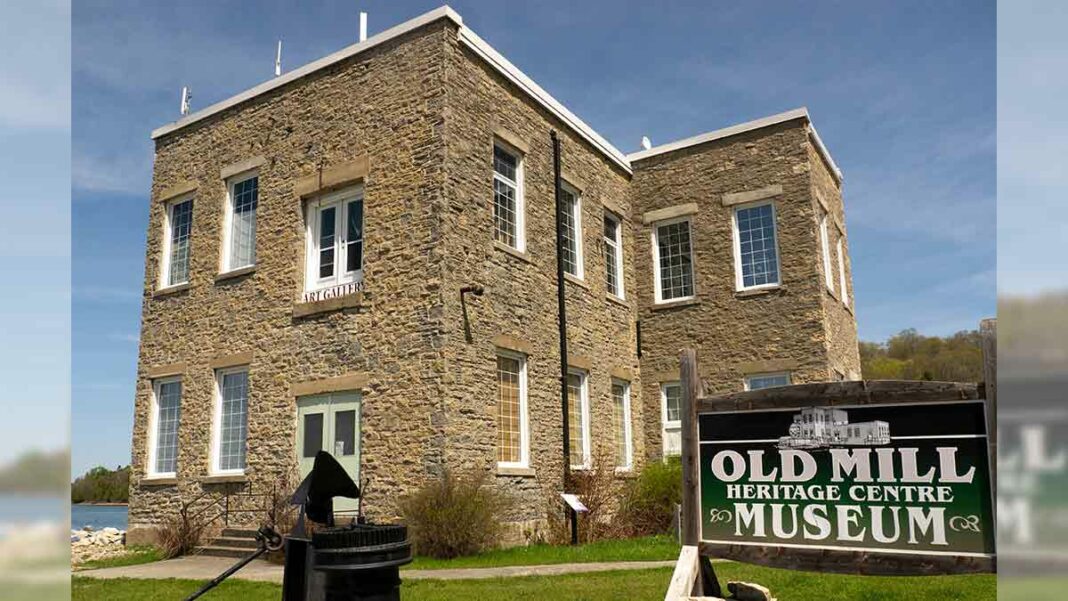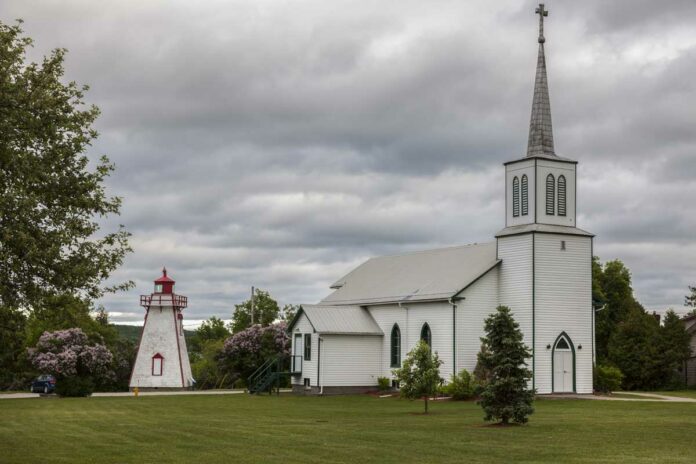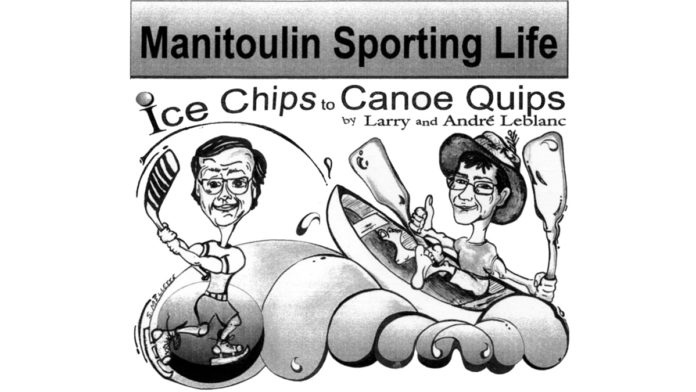KAGAWONG—Housed in a former pulp mill built of limestone in 1925 at the edge of the beach on Mudge Bay, Kagawong’s Old Mill Heritage Centre Museum collections are among the finest on Manitoulin Island. Always fascinating to visit, the Museum’s varied exhibits hold plenty of appeal for visitors of all ages.
Inside, the soaring ceilings and lofty windows are a perfect backdrop to the wide-ranging displays of memorabilia from Billings Township and farther afield amassed by the volunteers of the longstanding Museum Committee and curator Rick Nelson, all of them dedicated since 2007 to local historical preservation.
The building is a busy hub in the village of Kagawong, with municipal offices on the ground floor and public washrooms for changing into and out of swimsuits. On the second floor, Edwards Studios and Fine Art shows local handmade pottery, jewellery, wood carvings, textiles and paintings in a gorgeous gallery.
The Museum has been the setting for many thrilling displays throughout the years, most recently the two-year run of the stunning, comprehensive exhibition commemorating the sinking of ‘Canada’s Titanic,’ the Empress of Ireland. The wildly popular show about the ill-fated ship that tragically sank in the St. Lawrence River in 1914 with all 1,012 passengers and crew perishing attracted a record number of visitors.
Opening this Victoria Day holiday weekend is ‘Snapshot in Time: Vintage Cameras and Old Photographs,’ an eye-popping presentation of over a hundred rare and original camera models from the 1890s to the 1980s. The grouping has been assembled from the extensive private collections of local photography aficionados Chris Elliott of Mediaworks and David Wiewel of Café Obscura, both in Sudbury, Mark Pacey Design, Espanola and Dave Pulsifer, Little Current.
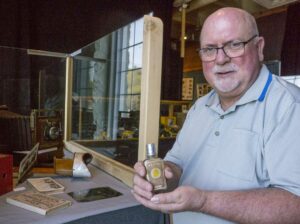
Leading a pre-opening tour is Mr. Pulsifer, the vintage camera consultant for the exhibit who works at the Manitoulin Health Centre in Little Current and has been a passionate photo-phile since his Grade 6 schooldays in Hamilton. He keeps a vast collection of Canon 35mm cameras at home, many of the Olympic F1 series from the ‘70s and ‘80s on display in this show; he points to one that was made for use by the US Navy, marked as such on the front. In the same display case are tiny “sub-miniature” cameras by Minolta, Minox and Crystar, sided by their minuscule rolls of film.
The earliest cameras here are large box cameras from the 1890s, in use by professional photographers who processed extremely cumbersome large format wet plates to produce photos. In a nearby case is a beautiful, mint-condition 5×7 view camera that came from Manitoulin’s Marshall family; called an Eastman View #2, it dates from 1914-1925 and is shown with a small bottle labeled ‘Flash Powder,’ a highly volatile mix that early photographers used to illuminate their photos. Held in one hand like a torch, the gunpowder-like chemical dust was set alight while the shutter was clicked by the other hand; some unfortunate photographers were killed by the resulting explosions.
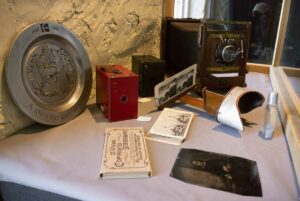
Early on, when photography was in its infancy, it was the exclusive territory of professionals and it’s easy to see why in this exhibit – the “massive beasts” were unwieldy and complicated to use, requiring strength to carry and much patience with which to execute photos. It wasn’t until the 1900s that cameras became more user-friendly for the general public in the form of smaller handheld pocket and box formats; the exhibit has many such examples, like the Kodak Brownie series of the 1930s-50s, the Model B, the Target, the Hawkeye, the Reflex and the Baby Brownie, the latter costing just $1.75; also in the 30s, the Jiffy was marketed by Eastman Kodak as the simplest, most user-friendly folding camera ever made.
Novelty cameras became popular, epitomizing how easy photography became for everyone and several are shown in this exhibition. A label on the all-plastic Mick-a-Matic in the shape of Mickey Mouse’s head urges the user (presumably a child) to “Treat me gently, I’m your pal.” The shutter on the rifle-shaped Russian Zenit is released by pulling the trigger; the Nimslo shoots images in 3-D; the underwater Nikonos floats.
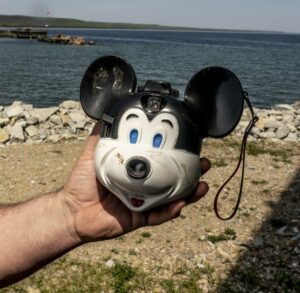
The selection of cameras is extensive – there’s the Auto Graphic with an opening at the back through which to write on the negatives with the accompanying metal pencil, the stereographic cameras that made two-image stereotypes to view in a stereo viewer, the huge ‘vest pocket’ cameras of the late ‘10s and ‘20s, the twin lens reflex press cameras of the 1950s and ‘60s and the compact cameras of WWII that eased the press photographer’s job in the fields of war.
‘Snapshot in Time’ is engrossing and worthy of a visit on its own, but it is far from the only exhibit to be seen in the Museum. In addition to the military room with its 1940s wooden cabinet radio that plays WWII broadcasts and its uniforms and memorabilia, there is a photographic history of the Old Mill and the sawmills of Billings and home movies from Whiskey Lane on Mudge Bay, filmed by the American families that came here in the 1920s whose descendants still own the cottage properties.
The mandate of the Museum Committee is to keep history alive, says member Dianne Fraser, and local families are a big part of this focus. Currently, a corner of the museum is dedicated to the donated artifacts of the Lloyd family, the photos, diaries and journals and even the doll clothes made from the wool of the sheep on the farm of Moses and Hannah Lloyd. The Lloyds came from England and settled in this area in 1879; their descendants are still here. Ms Fraser says the committee arranges displays so visitors can “get up close and personal, like in an art gallery.”
Many original photographs from the turn of the 20th century give a rare glimpse into the township’s history; a blacksmith shop is authentically reproduced, featuring tools gathered locally; walls of unique photos and clippings tell the story of the glory days of Harbour Island Resort and of the spectacular tragedy of Danny Dodge.
Curator Rick Nelson is immensely proud of the Old Mill Heritage Centre and Museum, making sure to mention the walls listing past and present donors and the little shop selling maps, cards and books.
Out in front of the museum, the log Post Office Museum will be open this summer. On July 13, as part of the museum’s annual Speakers’ Night series, journalist and author Steve Paikin will introduce his new book about former prime minister John Turner, complemented with live interviews and personal stories.
On August 10, History Day in Kagawong will be a ‘double feature,’ with a talk on early local rail transportation and telegram services by Little Current entrepreneur Jib Turner during the first half. After a short intermission, there will be a commemoration of the 60th anniversary of the JFK assassination presented by curator Rick Nelson.
A Bell and Howell Zoomatic movie camera, a replica identical to the one used to film the assassination in 1963, known as the Zapruder camera, will be on display at History Day as well as during the ‘Snapshot’ exhibition.
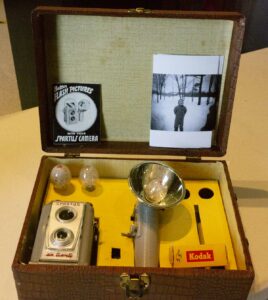
The Old Mill Heritage Centre Museum, Kagawong, open Saturday and Sunday in May. Open every day from 10 am to 5 pm in July-August. Call 705-282-1442 or visit www.kagawongmuseum.ca. Admission by donation.

